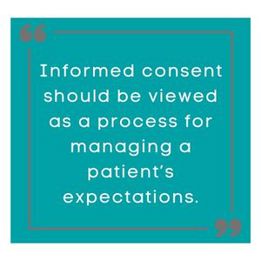
- Compliance
Medical Malpractice Claim: Lack of Informed Consent in Arizona
In Arizona, what are the best practices for informed consent with patients in order to protect your practice in case of a medical malpractice lawsuit?
What must an Arizona plaintiff prove to prevail in a medical malpractice lawsuit alleging lack of informed consent?
Informed consent is the process by which a patient learns and understands the purpose, benefits, potential risks, and alternatives of the proposed treatment options. By comparison, a “battery” occurs when a physician either performs a procedure or treatment without the patient’s consent or the procedure or treatment is outside of the patient’s consent. A battery claim, which may be included in lack of informed consent lawsuit, does not require expert testimony.
In any medical malpractice lawsuit for lack of informed consent, the plaintiff must prove (1) the duty of care owed to the patient; (2) breach of the duty; (3) that the breach proximately caused injury; and (4) damages.
A “lack of informed consent” lawsuit will turn on whether the physician provided appropriate information (as defined by the applicable standard of care) about the benefits, risks, and alternatives to the procedure or medical treatment at issue.
The plaintiff must prove by expert testimony the disclosure required by the applicable standard of care for the physician’s specialty and for the procedure or treatment. In a typical informed consent case, testimony on the appropriate disclosure will include:
- The patient’s diagnosis, if known;
- The nature and purpose of the procedure or treatment;
- The material risks and benefits of the proposed procedure or treatment;
- Reasonable alternatives;
- Relevant risks, benefits, and uncertainties of each alternative; and
- The risks and benefits of not undergoing the procedure or treatment.
The experts will differ in their opinions on the material risks and benefits of the procedure or treatment. In considering whether the standard of care was met by the defendant physician, the jury will consider the testimony of the physician and the patient. The physician may also testify about his or her custom and practice in providing informed consent. The written consent and/or medical record documentation is often the most important evidence because it was created at the time of the discussion. Finally, the jury will consider the testimony of the experts on the standard of care and breach thereof, and decide whether sufficient information was provided to meet the standard of care under the circumstances.
In an informed consent lawsuit, the plaintiff has experienced a significant risk/complication of the procedure or treatment resulting in injury irrespective of whether it was performed properly. In addition to proving that the consent was not “informed,” plaintiff must establish proximate causation for the complication. For lack of informed consent, this generally means that plaintiff must prove that a reasonable person in plaintiff’s position would have attached significance to the undisclosed material risk(s) of the procedure or treatment and would have decided against consenting to it.
However, it may be enough in Arizona to prove that the plaintiff would not have consented to the procedure or treatment. Either way, a plaintiff will not be able to prove causation if the jury concludes that the patient would have still consented to the procedure had a full disclosure been made.
How can practitioners optimize their informed consent discussions and forms to strengthen the defense of this type of claim?
Patients often have poor recall of informed consent discussions due to a variety of factors such as information overload, feeling overwhelmed from stress, low literacy, language barriers, being unfamiliar with medical terms, and distractions. There are a number of tools that practitioners can use to ensure patients are fully informed in order to defend against a lawsuit for lack of informed consent.
First, when obtaining informed consent, make sure to evaluate any potential mental capacity issues. In the event the patient is a child or elderly adult, for example, discussing risks, benefits, and alternatives with a parent, guardian, or surrogate decision maker is important to ensuring that the patient fully understands the options that the provider is presenting him or her with.
Informed consent should be viewed as a process for managing a patient’s expectations. For this reason, the discussion should be a realistic discussion of possible outcomes. This requires adequate time for a dialogue with the patient and allowing time for questions. This discussion should not be delegated to staff. Avoid medical jargon and simply explain the benefits and risks of the treatment. When appropriate, the use of diagrams and drawings are effective both with patients and jurors. If there are probabilities for success or failure, they should be discussed.
expectations. For this reason, the discussion should be a realistic discussion of possible outcomes. This requires adequate time for a dialogue with the patient and allowing time for questions. This discussion should not be delegated to staff. Avoid medical jargon and simply explain the benefits and risks of the treatment. When appropriate, the use of diagrams and drawings are effective both with patients and jurors. If there are probabilities for success or failure, they should be discussed.
Once the discussion is complete, documentation is essential. If you have a form to be signed, it should contain information on diagnosis, who will perform the proposed procedure or treatment, the proposed treatment plan, its benefits, risks, and potential alternatives. Ideally, the physician will give the patient time to read through any applicable information regarding the procedure or treatment and then ask whatever questions he or she may have about the information contained in that form.
Additionally, it is important to document in the medical record that the informed consent discussion occurred, noting that the patient and physician discussed the risks, benefits, and alternatives. Of course, obtaining the patient’s dated signature on the consent form, also signed by the physician, and adding a copy to the patient record is a critical step in defending against a malpractice claim founded in lack of informed consent. The medical record is the most important and first line of defense.
Finally, if the patient declines the recommended procedure or treatment, you should also document the informed refusal, including the reasons for the decision.
